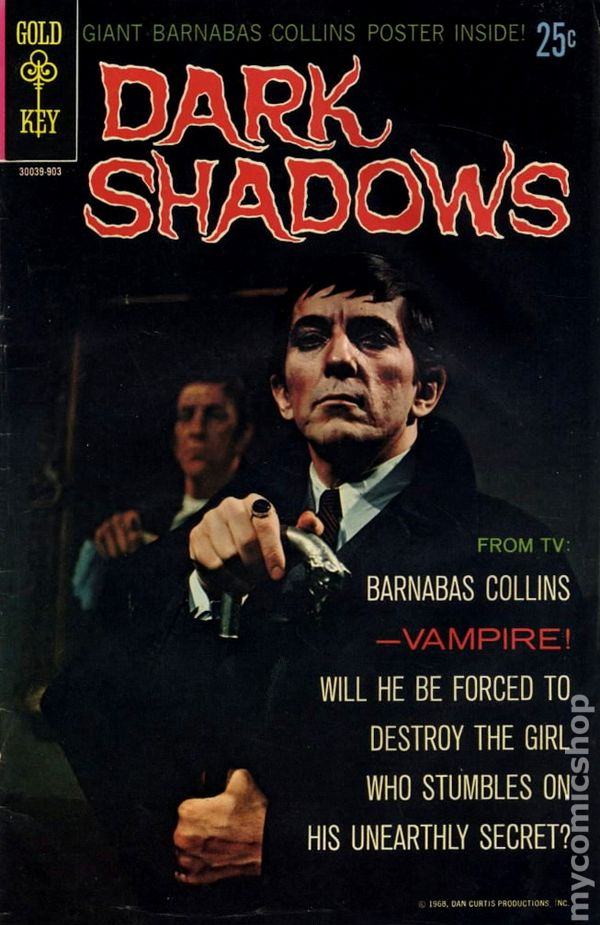
“The fools! Of course there is no book! It is but a shabby lie to hide the truth; that I sleep with the dead during the day and spend my nights prowling for blood!”—-Barnabas Collins, Dark Shadows, issue # 35.
I’ve written here before about “Dark Shadows,” the Gothic T.V. soap opera with supernatural themes and a large following in the LGBT community. Those who were around in the early 1970s may remember that there was a comic book version as well. Produced by Gold Key Comics the comic book (we’d call them “Graphic Novels” now) lasted an amazing 35 issues and was on the racks some five years after the series vanished into the television shadows.
Dark Shadows #1 first showed up in late 1968 (with a cover date of 1969, that’s the publishing biz!) and it took a few of its quarterly issues for the comics to find their footing. In the first issues, vampire Barnabas Collins is pretty much the whole deal as a monster; his solution to a problem is to plan to kill somebody. His edges have softened a bit and he is more heroic by the time the comics hit its stride in issue #8. The issue also features the first of many covers that were not publicity photos from the show, the illustration (by George Wilson, whose instantly recognizable style appeared on paperback and magazine covers for decades including depicting Tarzan,) is an eye-grabber: A surreal orange background with an open coffin as Barnabas emerges as a shadowy silhouette of a huge bat, with actor Jonathan Frid’s face, and clutching Barnabas’ iconic silver-headed cane as a girl runs away in terror!
And the artwork is part of the appeal; a lot of the illustrated covers are stunning; the interior artists included Joe Certa, a longtime comics artist most famous for designing “The Martian Manhunter” in the ‘50s. The artists have serious comics credentials, Jack Sparling worked in comics for decades and they had the challenge of making the characters look like the actors from the series. As for those characters, the comics stuck to Barnabas, Quentin, Dr. Julia Hoffman, Roger Collins, Elizabeth Collins and Professor Stokes. Willie Loomis shows up in issue #1 and he and Victoria Winters get a mention in a later issue but are not seen. (David Collins shows up with Barnabas on the cover of issue #6 in publicity still from the show that likewise never appeared on the series.)
Much of the writing was done by Don J. Arneson, with other stories penned by Gerry Boudreau, John Warner and Arnold Drake. All have solid comics credentials; Drake was the co-creator of Deadman and The Doom Patrol. (The writers and artists were not credited in the books at the time of publication.)
As for the stories, they followed the general themes of the T.V. series; lost love, curses, cures for curses, supernatural menaces and threats of exposure for our antiheroes Barnabas and Quentin. Highpoints include issue #24 with Drake’s “On Borrowed Blood,” where a transfusion from Barnabas makes the president of an island nation unimaginably powerful, issue #11s “The Thirteenth Star,” where Barnabas battles a golem created by a Collins ancestor to destroy creatures of evil, such as vampires. Written by Arneson, it features a trip to 2071, a year that is now just over a half-century away. Also excellent was Arnold Drake’s “My Blood or Yours,” where a cure for werewolf Quentin causes him to want to destroy Barnabas! Several issues show that vampires have no shadows, a trick that would have been hard for the low-budget T.V. series to pull off in the ‘60s. A couple of issues feature in-joke references to Marvel’s Doctor Strange, and issue #34 features a reference to a fortunetelling game advertised in comic books in the 1960s!
The stories are melodramatic, sometimes hokey, sometimes spooky and usually a lot of fun, with fantasy and drama and lines like “And where a solid body stood, there is only an empty scream.” The continuity does not always jibe with the T.V. series and in a one-issue gaffe, Roger and Elizabeth are depicted as husband and wife, not brother and sister. It all ends in fine style with issue #35 and “The Missing Manuscript,” written by Warner with cover and interior art by Certa. In it, Barnabas’ secret is endangered and we meet a mysterious Collins ancestor who we have met in an earlier issue. Seven years and 35 issues is not bad for a comic book, especially one that lasted five years after the original series left the air.
The early 1970s weren’t the best of times for me personally; I was going through surgery and also going to school being the weird-looking-guy who talked funny. Comic books and T.V, shows were a refuge and (I didn’t realize) an inspiration to my future career as a writer.
And I hope someday to come up with a title as cool as issue #30s “The Weekend Witch-Hunters.”
Jeff Baker still has a near-complete run of the Dark Shadows comics. He also has a shadow. He lives happily with his husband Darryl Thompson and blogs about writing and reading sci-fi, fantasy and horror around the thirteenth of each month. He posts fiction on his own blog https://authorjeffbaker.com/ and can be found on Facebook at https://www.facebook.com/Jeff-Baker-Author-176267409096907/



